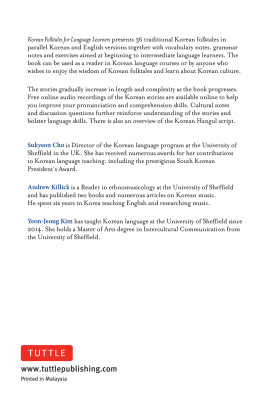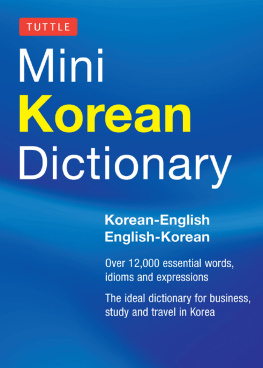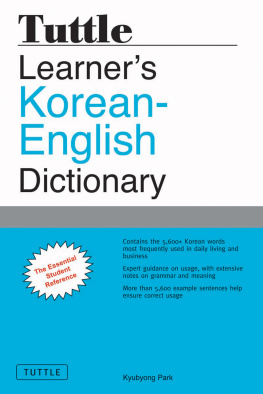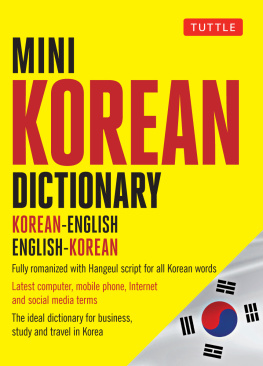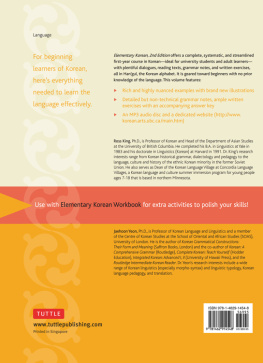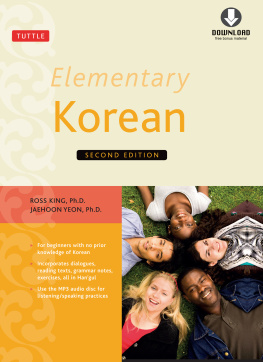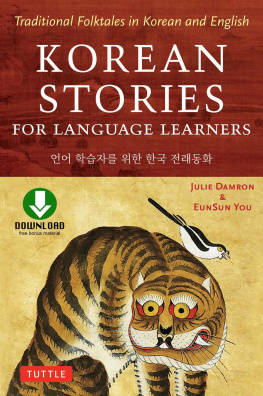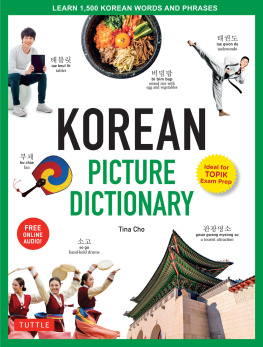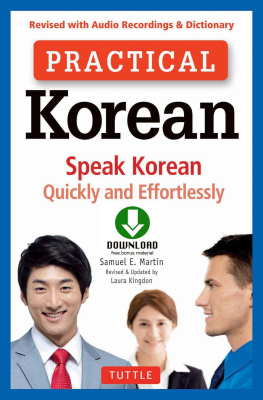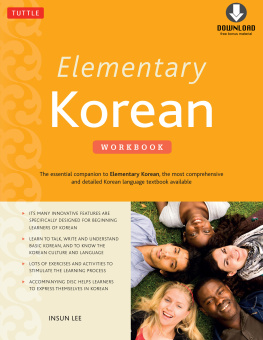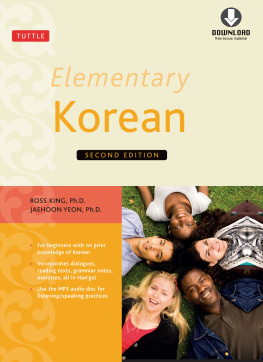Table of Contents
Guide
To Access the Audio Recordings:
Check that you have an internet connection.
Type the URL below into your web browser:
https://www.tuttlepublishing.com/korean-folktales-for-language-learners
For support you can email us at .
Contents
How to Use This Book
In this book youll find a collection of well-known folktales that are much loved by Koreans, featuring wily animals and wise animals, fighting families and loving families, humor, horror and magic, as well as legends about the creation of Korea.
Each story is presented with parallel Korean and English text on facing pages. You can challenge yourself by reading the stories in Korean, using the English text as a guide if needed, or you can simply enjoy the English stories. For students who are unfamiliar with the Hangul alphabet, this is presented on , followed by reading and writing exercises that will allow you to master the basics.
The book goes from short, simple stories to longer, more complex ones. To tell the stories clearly we use some grammatical forms that are considered intermediate even in the first part of the book. As far as possible we use expressions that are common today rather than old-fashioned forms, to be of practical use to the Korean language learner. English translations aim to be faithful to the original, but where a literal translation would sound awkward, a freer translation has been given. Each chapter also contains the following elements:
Vocabulary
A comprehensive list gives key words from the story in Hangul and English.
Selected grammar points
Key grammar points from the story are explained, along with example sentences.
After reading the story
Comprehension questions encourage your deeper understanding of the story and reinforce the vocabulary and grammar presented in each lesson.
Lets talk!
Students working with a teacher can use the prompts as a starting point for discussion. Self-study students can explore issues from the story in writing.
Notes on Korean culture
Notes on the cultural background to each story help you gain valuable insights into Korean society.
An English-Korean glossary is provided at the end of the book.
Each story is available as an online audio recording made by native Korean speakers, via the link on .
The Korean Language:
an Overview
The Korean Language
Korean belongs to a family of languages that is thought to include Japanese and possibly even Mongolian, Finnish and Hungarian. Although Korean has no structural relationship with the Chinese language, a large portion of Korean vocabulary has cognates in Chinese.
In contrast with some European languages, in Korean the verb always comes at the end of the sentence, with the basic sentence structure being: subject object verb. So a sentence would be structured as, for example, My friend the book reads rather than My friend reads the book.
In addition, particles are added to nouns to indicate their function in the sentence. In Korean you would say: My friend (+ subject particle) the book (+ object particle) reads.
In Korean, verbs must change their forms in order to show tense and mood. The tense of a verb indicates whether the action or state is taking place in the present, future or past. There are five moods in Korean, which are declarative (statements), interrogative (questions), imperative (commands), propositive (suggestions) and exclamatory (exclamations).
Perhaps one of the most interesting features of Korean is the extensive use of honorific language. When speaking in Korean, you must use a level of respect appropriate to the person being addressed or the person being discussed. The language used to address a small child will differ significantly from that used to a friend, and that too will be different from the level of speech used to a senior colleague or elderly relative. There are some verbs and nouns which have their own honorific equivalents: for example, the word for ones own wife is urijipsaram while another persons wife is referred to as buin . Other verbs rely on infixes (syllables attached directly to the verb stem) or honorific verb endings.
The Korean Alphabet
Before the invention of the Korean alphabet in the fifteenth century, people in Korea borrowed Chinese characters when they wanted to write something.
However, learning Chinese characters is quite difficult because of their complexity and quantity. As a result, most ordinary people, and even some noblemen, were illiterate.
However, in 1443, a new Korean alphabet called Hangul (also spelled Hangeul) was promulgated by the fourth ruler of the Joseon Dynasty, King Sejong the Great, who is unquestionably the most loved king in all of Korean history. Hangul was developed as a means of transcribing the sounds of Korean, which made reading and writing the language easier and accessible to all the Korean people. King Sejong the Great called the alphabet Hunmin Jeongeum or Proper Sounds to Instruct the People. In his Introduction to Hunmin Jeongeum , he wrote, Talented people will learn Hangul in a single morning and even foolish people will understand it in ten daysa point to be borne in mind by all would-be students of the Korean alphabet!
Even after the introduction of Hangul, Korean scholars and officials were reluctant to abandon the use of Chinese characters, which had for so long been a symbol of learning and status in Korean society. However, from the seventeenth century, the Hangul alphabet was used both in court circles and among the ordinary people, and its use was encouraged by the Progressive Movement in the late nineteenth century. The first Hangul newspaper, The Independent was published in 1896, but during the Japanese colonial period (19101945), the use of the Korean language was severely restricted and from 1938 it was forbidden to use Korean in schools. Following liberation from Japanese rule in 1945, the Korean language flourished again; such is the Koreans pride in their language and their alphabet in particular that in 1945, October 9th was established as Hangul Day (), a national holiday. For a while, a mixture of Hangul and Chinese characters was used but these days Hangul is used almost exclusively both in South Korea and North Korea.
The Hangul alphabet has 40 characters (letters) that are combined in all sorts of different ways to form words. In modern Hangul, there are 19 consonants and 21 vowels, including compound vowels. Vowels and consonants have different shapes so they are easy to distinguish visually.
Hangul is an alphabet in that it has vowels and consonants like the Roman
alphabet, but at the same time it is a syllabic writing system like Chinese charac-
ters. When you see an unfamiliar English word, you dont know how many syl
lables it has unless you know how to pronounce it. But with Hangul, one block
of letters is one syllable. This, in addition to the fact that Hangul pronunciation is fully predictable from the spelling, makes Hangul relatively easy to read compared to other languages. That is why Hangul is admired as the worlds most efficient alphabet by many linguists.
2.1 Consonants
There are ten basic consonants in Korean, of which four are aspirated (pronounced with a breath of air) and five are tense (pronounced with a "hard" sound). Each symbol is practically a diagram of how to pronounce it. For example, the shapes of five of the consonants reflect the shape of the mouth and tongue. The remaining consonants are adaptations of these letters. The pronunciation of many of the consonants changes when they come between vowels or in combination with other consonants.

